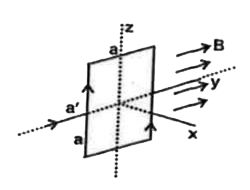Figure shows an isosceles triangle wire frame with apex angle equal to (π)/2. The frame starts entering into the region of uniform magnetic field B with constant velocity v at t =0. The longest side of the frame is perpendicular to the direction of velocity. If i is the intantaneous current through the frame then choose the alternative showing the correct variation of i with time.





The correct Answer is:D


Area inside the field A=(12V2t2)×2=V2t2
ϕ=BV2t2⇒dϕdt=BV22t
e=2BV2t⇒I∝t
Similar Questions
A square loop of a conducting material of side l and resistance r is dragged through a uniform magnetic field B with uniform velocity v keeping the plane of the loop perpendicular to the direction of the field. What is the current flowing through the loop?
View SolutionA square frame with side a and a long straight wire carrying a current i are located in the same plane as m shown in figure. The fram translates to the right with a constant velocity v. Find the emf induced in the frame as a function of distance x.

View Solution
Knowledge Check
The figure shows a right angled isosceles triangle wire frame. The wire frame starts entering into the region of uniform magnetic field with constant velocity v at t=0. If I is the instantaneous current through the frame, then choose the corrent graph between I & t.
 A
A B
B C
C D
D
A triangle loop as shown in the figure is started to being pulled out at t=0 from a uniform magnetic field with a constant velocity v.Total resistance of the loop is constant and equals to R.Then the variation of power produced in the loop with time will be:
 Alinearly increasing with time till whole loop come outBincreases parabolically till whole loop comes outCPαt3 till whole loop come outDwill be constant with time
Alinearly increasing with time till whole loop come outBincreases parabolically till whole loop comes outCPαt3 till whole loop come outDwill be constant with timeA triangular loop as shown in the figure is started to being pulled out at t=0 form a uniform magnetic field with a constant velocity v. Total resistancee of the loop is constant and equal to R. Then the variation of power produced in the loop with time will be :
 Apower produced in the loop increasing linearly with time till whole loop comes outBpower produced in the loop increases parabolically till whole loop comes outCCurrent in the loop increases linearly with time till whole loop comes outDpower produced in the loop will be constant with time
Apower produced in the loop increasing linearly with time till whole loop comes outBpower produced in the loop increases parabolically till whole loop comes outCCurrent in the loop increases linearly with time till whole loop comes outDpower produced in the loop will be constant with time
A long wire carrying current I is connected to a rectangular metallic frame as shown in the adjacent figure. A uniform magnetic field B along y-axis is switched on. The mass linear density of the frame is λ. The frame lies in y-z plane, The instantaneous angular acceleration of the frame is

View SolutionA conducting square frame of side 'a' and a long straight wire carrying current I are located in the same plane as shown in the figure. The frame moves to the right with a constant velocity 'V'. The emf induced in the frame will be proportional to

View SolutionAn equilateral triangular conducting frame is rotated with angular velocity ω in a uniform magnetic field B as shown. Side of triangle is l. choose the correct options

View SolutionA rectangular loop of wire in the plane of the paper starts outside a perpendicular uniform magnetic field directed into the paper as shown in the following figure. The loop is pulled with a constant velocity through the magnetic field and out the other side. Which of the following graphs would best represent the variation of the electric current in the wire with time?

View SolutionA wire KMN moves along the bisector of the angle θ with a constant velocity v in a uniform magnetic field B perpendicular to the plane of the paper and directed inward. Which of the following is correct?

View Solution
